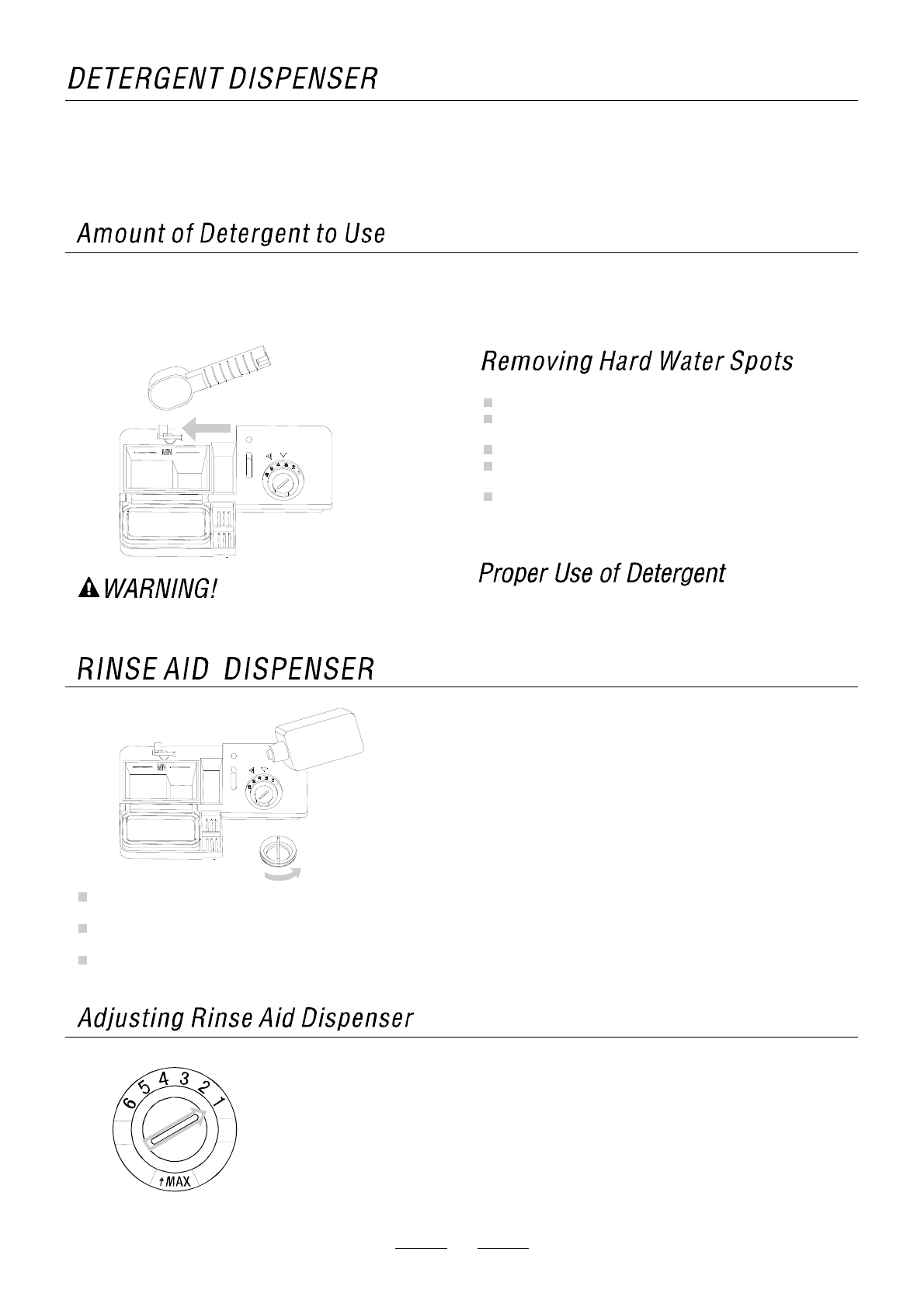
5
Dishwasher detergent iscorrosive! Take care tokeepit out
ofreach of children.
IF THE WATER ISN'T TOO HARD, YOU MAY ALSO PREVENT THE FORMATION OF DEPOSITS BY ADDINGDETERGENT.
The amountof detergent needed can vary dueto differencesin waterhardness. To determinethewater hardness in yourarea,
contact your local water utilityor area water softening company. Theharder the water, the more detergent you may need.
Remember, you should adjust the amount of detergentyouuse by small amounts until you find the correctamount.
To remove hard water spots, try the following:
Run dishes through a normal wash program.
Remove all metal dishware,such ascutlery, pans,etc.,
from the dishwasher.
Do not adddetergent.
Pourtwo cups of vinegar into abowl and setthe bowl face
up on the lower rack ofthedishwasher.
Runthedishesthrougha normalwashprogram.
If this doesn't work, try the same process with 1 / 4 cup of
citric acid crystals instead of vinegar.
Use only detergent specifically made for use in dishwashers.
Keep your detergent fresh and dry. Don't put powder detergent
into the dispenser until You're ready to wash dishes.
Therinse aidis releasedduring the final rinse toprevent water
fromforming droplets on your dishesthatcan leavespotsand
streaks. It also improves drying by allowing water to "sheet" off
the dishes.
Your dishwashers are designed to use liquid rinse aids. The
rinse aiddispenser is located inside the door next tothe
detergent dispenser. Tofill the dispenser,openthe cap and
pour therinseaidinto the dispenser until the level indicator
turns completely black.The dispenser holds about 100 ml of
liquid rinse aid.
Becarefulnotto overfill thedispenser,becausethiscould
cause oversudsing. Wipe away any spills with a damp cloth.
Don't forget to replacethe cap before you closethedishwasher
door.
If you have soft water,you may not need rinse aid for it may
cause awhitefilmto develop onyour dishes.
YOU MAYNOT ADD TOO MUCH DETERGENT TO PREVENT THE FORMATIONOF DEPOSITS BECAUSE YOURDISHWASHERS
HAVE SPECIALLY-DESIGNED WATER SOFTENERS.
The dispensermust be refilled beforethe start of each wash cyclefollowingthe instructionsprovidedinthe" WashCycle
Table".Your dishwashers than conventional dishwashers. Generally, only one tablespoon of
detergent is needed for anormalwashload.Also,more heavily soiled items need more detergent. Always add the detergent just
before startingdishwasher, otherwiseit could get damp and will notdissolveproperly.
use lessdetergentand rinse aid
To openthe dispenser, turn the cap to the "open" (left)
arrowand lift itout.
Pour the rinse aidinto thedispenser, being careful not to
overfill.
Replace the cap by inserting it aligned with "open" arrow
and turning it to the closed (right) arrow.
A measured amountof rinse aid is released duringthefinalrinse. Aswithdetergent, the amount
ofrinse aid needed for your dishes depends on the hardness of the waterin your area. Too much
rinse aid can resultin lather offoaming and causecloudiness or steaks on your dishes.If the
water in your area is very soft,you may not need rinseaid. If you do,you can dilute the rinse aid
with anequal amountof water.
The rinse aid dispenser has six settings. Always start with the dispenser set on " 1 ". If spotsand
poor dryingare problems,increasetheamount of rinse aiddispensed byremoving the dispenser
lid androtating the dial to"2". If the dishes still are notdrying properly or are spotted, adjust the
dial to the next higher numberuntilyour dishes are spot-free. We suggest you to set on "4" .
If only four settings we suggest you set on "2".


















